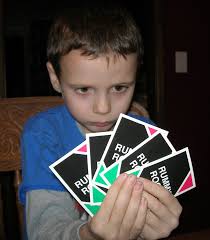Powerhouse Vocabulary Builder
In 25 years as a reading tutor, one vocabulary-building tool stands out above all the others: Rummy Roots. It’s not fancy — just six decks of cards. The first three come together as Rummy Roots and the second three are sold as More Roots. The package comes with instructions for several games, some complex and challenging enough for college students.
But I ignore all the complicated games and just use the cards for one simple game, Go Fish. The object is to make pairs, matching a black English word card with its green Greek or red Latin card. For example, the black card “write” pairs with the green card “gram/graph.” Think about how much more fun it is to learn word roots as a game, instead of filling out worksheets! Students actually beg to play this game over and over, thus getting the repetition needed to send those words to long-term memory. A round takes about 5 minutes, so it can be worked in at the beginning or end of another lesson.
Good for Any Age
I use Rummy Roots with almost every student I teach, from those just learning to read, right up through high school. The level of support needed changes for different students, of course. Importantly, the game allows students of different abilities, reading levels, and ages to play together. Teaching a student to play takes less than five minutes. I provide a typed list of all the words in the deck with the meanings. My list presents all words in the game in alphabetical order. This allows students to practice using a dictionary skill.
I think Rummy Roots should provide this list with the game. However, the game comes with the words printed in super-tiny font on a teensy paper. This simply frustrates the students. I let students use my list as long as they want. When they don’t need the list anymore, they quit using it. Then they ask to try the next set of cards. By the time a student masters all six sets, he or she understands many of the Greek and Latin word roots that inform scientific and mathematical vocabulary.
Great for Dyslexic Students
My dyslexic students LOVE this game. They excel at it by using their pattern recognition strengths. By learning this advanced vocabulary on separate cards, they don’t get them tangled up. The color-coding helps, too. Since dyslexic students may work at a reading level far below their intellectual level, this game lets me ramp it up for them, by casually inserting information about the super-cool words you can make with these roots, like microphotography — a word built from micro (small), photo (light), and graph (writing). One day, a student I’d been playing with for a few sessions, came in after school and reported, “Today the science teacher put a new vocabulary word on the board, and asked if anyone could figure out what it meant. I was the only one in class who could do it!” An experience like that for a dyslexic student is literally game-changing!
Perfect for One-on-One or Small Groups
Once students know how to play, they can do it themselves in small groups in the classroom. A tutor can use it one-on-one with a student; the best way for a student to learn and build confidence. If students are allowed to use their word list as long as they want it, there’s no shaming or embarrassment tied to the words for students who need a while to master the list. It puts everyone on an even footing, whether dyslexic or not. Teachers know that material learned while having fun gets remembered. Material learned when bored, angry, or frustrated tends to be forgotten; only the negative emotion is remembered. So fun games make the best choice for memory material, and this one is a treasure!
Reviewed by Yvonna Graham, M.Ed.
www.dyslexiakit.net
@GrahamYvonna
